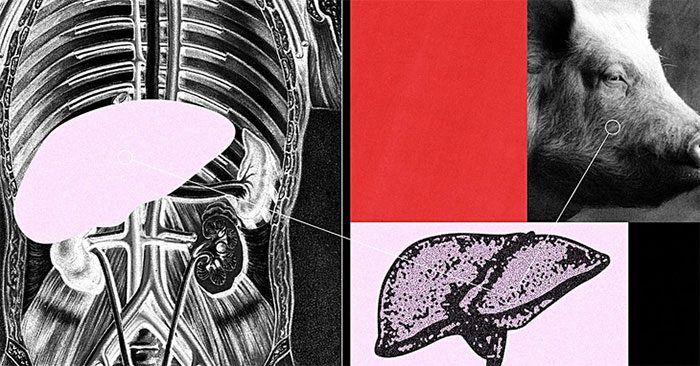In a recent experiment, for the first time, a pig liver filtered blood for a brain-dead patient over three days. This breakthrough could open up new hope for those awaiting organ transplants.
Doctors at the University of Pennsylvania (USA) have recently announced the astonishing results that they used a pig liver to filter the blood of a deceased donor.
This concept is expected to evolve into a “bridge for transplantation” for critically ill patients, serving as a temporary organ transplant to help them survive until they receive a human liver donation.

Currently, there aren’t enough organs for transplant patients, and the new research from the University of Pennsylvania is bringing much hope – (Photo: Globalnews.ca).
“Blood perfusion”
In the experiment conducted in December 2023, researchers maintained the circulatory and respiratory systems of the deceased donor artificially after confirming that the individual was brain-dead. The organs of this individual were unsuitable for donation to patients on the transplant waiting list, and the family consented to allow the use of the body for the experiment, according to Penn Medicine News.
“Blood perfusion” is the technical term for the process of circulating blood through an organ. The liver of the deceased donor was kept intact throughout the process, unlike xenotransplantation, which involves transplanting animal organs into humans.
Instead, a genetically modified pig liver was connected to the deceased donor’s circulatory system from outside the body to minimize the risk of rejection.
During the time the donor’s blood was circulated through the pig liver, researchers observed no inflammation in the liver and no issues with the donor’s body. During this period, the pig liver produced bile and maintained normal blood acidity levels in the donor.
“We were all surprised because the liver still looked quite good after three days,” said Dr. Abraham Shakes from the University of Pennsylvania’s transplant institute, who supervised the study. They decided to stop the experiment after three days.
This result is only the first phase of a larger study that the research team is conducting, with three more deceased donors set to participate. In the next phase, they will attempt to remove the donor’s liver to determine if this method can indeed serve as the “bridge” for transplantation they hope for.
Bridge

Pig liver could be a transplant bridge for liver patients – (Photo: Wired).
Organ transplantation is one of the biggest breakthroughs in medicine in the 20th century. However, the reality is that there are currently not enough organs for transplant, and the liver is no exception.
The liver is the largest organ in the body, performing many vital functions such as producing bile for digestion, filtering and regulating blood clotting, controlling blood sugar levels, and helping fight infections.
Currently, there is no way to replace the liver’s functions with machinery, like dialysis for the kidneys, so patients with liver failure have no choice but to undergo a liver transplant.
This experiment could be a step forward towards using pig organs to assist patients with severe liver disease while waiting for a liver transplant, which can take up to five years. If this method proves safe and feasible, it could help keep the sickest patients alive during a critical period, maximizing their chances of receiving a transplant.
It also has the potential to be used as a temporary treatment for liver damage, similar to extracorporeal membrane oxygenation (ECMO) for the heart and lungs. “If it can increase the chance of recovery, they might avoid needing a transplant,” Dr. Shakes said.
This is why this solution could be the “bridge” for liver transplant patients. For experts, the combination of pig organs and machinery is a breakthrough but still requires further research.
Dr. Parsia Vagefi, a surgical professor at the University of Texas, believes it remains to be seen whether the combination of gene editing and blood perfusion devices can help support patient survival.
“This is a push for innovation to help address the organ shortage. But I think we need to be aware of the reality that more research is needed,” Wired quoted Dr. Vagefi as saying.
Seeking Solutions from Pigs
The idea of transplanting pig livers is not new. In the 1960s and 1970s, over 100 experimental surgeries were performed on patients with liver failure. However, this ceased once organ donation from deceased donors became permitted.
In the 1990s, researchers at Duke University conducted a series of similar experiments on people with liver failure but were unsuccessful, according to Wired.
In 2022 and 2023, surgeons at the University of Maryland performed the world’s first surgeries transplanting genetically modified pig hearts into heart patients. Both recipients had heart failure but did not qualify for conventional human organ transplants.
The first patient, David Bennett, lived for two months before passing away in March 2022. The second patient, Lawrence Faucette, died in October 2023, six weeks after the transplant.
Additionally, there have been several experiments involving temporary pig kidney transplants into brain-dead donors for research purposes. The U.S. Food and Drug Administration has also allowed some patients on the organ transplant waiting list to participate in studies using pig hearts or kidneys.



















































